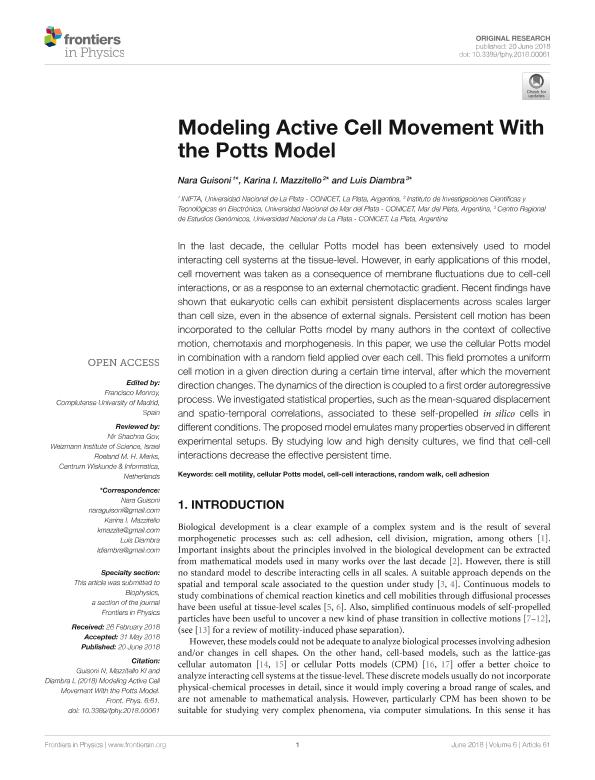Mostrar el registro sencillo del ítem
dc.contributor.author
Guisoni, Nara Cristina

dc.contributor.author
Mazzitello, Karina Irma

dc.contributor.author
Diambra, Luis Anibal

dc.date.available
2019-10-01T14:37:28Z
dc.date.issued
2018-06-20
dc.identifier.citation
Guisoni, Nara Cristina; Mazzitello, Karina Irma; Diambra, Luis Anibal; Modeling active cell movement with the Potts model; Frontiers Research Foundation; Frontiers in Physics; 6; JUN; 20-6-2018; 1-11
dc.identifier.uri
http://hdl.handle.net/11336/84898
dc.description.abstract
In the last decade, the cellular Potts model has been extensively used to model interacting cell systems at the tissue-level. However, in early applications of this model, cell movement was taken as a consequence of membrane fluctuations due to cell-cell interactions, or as a response to an external chemotactic gradient. Recent findings have shown that eukaryotic cells can exhibit persistent displacements across scales larger than cell size, even in the absence of external signals. Persistent cell motion has been incorporated to the cellular Potts model by many authors in the context of collective motion, chemotaxis and morphogenesis. In this paper, we use the cellular Potts model in combination with a random field applied over each cell. This field promotes a uniform cell motion in a given direction during a certain time interval, after which the movement direction changes. The dynamics of the direction is coupled to a first order autoregressive process. We investigated statistical properties, such as the mean-squared displacement and spatio-temporal correlations, associated to these self-propelled in silico cells in different conditions. The proposed model emulates many properties observed in different experimental setups. By studying low and high density cultures, we find that cell-cell interactions decrease the effective persistent time.
dc.format
application/pdf
dc.language.iso
eng
dc.publisher
Frontiers Research Foundation

dc.rights
info:eu-repo/semantics/openAccess
dc.rights.uri
https://creativecommons.org/licenses/by-nc-sa/2.5/ar/
dc.subject
CELL ADHESION
dc.subject
CELL MOTILITY
dc.subject
CELL-CELL INTERACTIONS
dc.subject
CELLULAR POTTS MODEL
dc.subject
RANDOM WALK
dc.subject.classification
Biofísica

dc.subject.classification
Ciencias Biológicas

dc.subject.classification
CIENCIAS NATURALES Y EXACTAS

dc.subject.classification
Biofísica

dc.subject.classification
Ciencias Biológicas

dc.subject.classification
CIENCIAS NATURALES Y EXACTAS

dc.title
Modeling active cell movement with the Potts model
dc.type
info:eu-repo/semantics/article
dc.type
info:ar-repo/semantics/artículo
dc.type
info:eu-repo/semantics/publishedVersion
dc.date.updated
2019-09-27T14:34:12Z
dc.identifier.eissn
2296-424X
dc.journal.volume
6
dc.journal.number
JUN
dc.journal.pagination
1-11
dc.journal.pais
Suiza

dc.description.fil
Fil: Guisoni, Nara Cristina. Consejo Nacional de Investigaciones Científicas y Técnicas. Centro Científico Tecnológico Conicet - La Plata. Instituto de Investigaciones Fisicoquímicas Teóricas y Aplicadas. Universidad Nacional de La Plata. Facultad de Ciencias Exactas. Instituto de Investigaciones Fisicoquímicas Teóricas y Aplicadas; Argentina
dc.description.fil
Fil: Mazzitello, Karina Irma. Consejo Nacional de Investigaciones Científicas y Técnicas. Centro Científico Tecnológico Conicet - Mar del Plata. Instituto de Investigaciones Científicas y Tecnológicas en Electrónica. Universidad Nacional de Mar del Plata. Facultad de Ingeniería. Instituto de Investigaciones Científicas y Tecnológicas en Electrónica; Argentina
dc.description.fil
Fil: Diambra, Luis Anibal. Universidad Nacional de La Plata. Centro Regional de Estudios Genómicos; Argentina. Consejo Nacional de Investigaciones Científicas y Técnicas; Argentina
dc.journal.title
Frontiers in Physics
dc.relation.alternativeid
info:eu-repo/semantics/altIdentifier/url/https://www.frontiersin.org/articles/10.3389/fphy.2018.00061/full
dc.relation.alternativeid
info:eu-repo/semantics/altIdentifier/doi/http://dx.doi.org/10.3389/fphy.2018.00061
Archivos asociados
